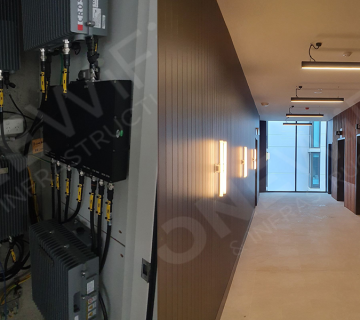With 5G implementation in full swing and rising mobile user expectations it is critical for In-building coverages to be ready for an upgrade. First in a series of articles, this piece discussed the basics – what is DAS & RAN in the In-building coverage context? And what policy makers need to consider while planning for design specifications in a world which is more connected than ever?
The much anticipated MCF 2021 DAS design specifications were released in June, albeit at the stage of draft for industry comment. However, whatever the detail of the final document, the importance of the 2021 specification release is that it will extend the scope of In-Building Coverage (IBC) Solutions to include support of 5G technology. The upgrade from 4G to 5G is not just a simple version upgrade. It requires careful consideration of infrastructure and implementation requirements to support 5G.
WHAT IS DAS & RAN?
Before we get too deep into the upgrade pathway to 5G and the latest draft release from the Mobile Carriers Forum (MCF), let’s be clear on the fundamentals – What is a DAS? Why might a DAS be important? And what do the MCF’s DAS specifications serve to do?
A Distributed Antenna System (DAS) is typically implemented to deliver indoor coverage in situations where the external mobile network does not provide reliable service to within a building. The DAS consists of the cabling, combining and distributive components, and antennas. Some DAS use active equipment such as Radio Units and digital transport systems.
However, the DAS by itself cannot provide an IBC Solution. An IBC Solution also requires a signal source.
The signal source is provided by a Mobile Network Operator’s Radio Access Network (RAN). Connection to the DAS is usually provided by the siting of a Base Station inside the building. It can also be provided by taking signals off air by the use of a donor antenna however this method has limited capability.
Simply put, the DAS extends the coverage of the RAN by faithfully distributing the radio signals throughout the building.
The DAS must be capable of supporting services for all Mobile Network Operators (MNOs) and therefore the building owner must provide facilities to accommodate the RAN and associated equipment for all MNOs.
FOOD, WATER, AIR AND MOBILE COVERAGE
Ubiquitous and uninterrupted Mobile coverage is a user expectation these days, including inside buildings. Conventional wisdom identifies that 80% of calls originate from inside buildings and for Commercial Buildings lack of coverage is a serious barrier to productivity. But building materials such as concrete, steel, glass along with internal partitioning work against signal penetration. The result is dropped calls, slow data speeds or worse – no coverage at all – which is quite a concern when emergency situations are considered. Weighing heavily on this is the fact that the high capacity frequency bands associated with 5G are those that are weakest in penetrating and pervading buildings.
For many buildings these days, the facility of DAS infrastructure supporting Mobile coverage is a specified feature analogous to the utility staples of water, electricity, gas and even Wi-Fi. The range of buildings in scope is wide, across both Public and Private facilities including Airports, Transport Hubs, Sports Stadiums, Convention Centres, Hospitals, Commercial Buildings including High Rise and Campus environments, Shopping Centres and Large Residential.
THE ROLE OF THE MOBILE CARRIERS FORUM (MCF)
To ensure the DAS will faithfully represent the MNO’s RAN inside buildings, specifications have been created. The specifications are produced by the Mobile Carriers Forum (MCF), a group within the Australian Mobile Telecommunications Association (AMTA). The MCF is a cooperative engaging representatives from Optus, Telstra and TPG (Vodafone) to set requirements for shared network infrastructure such as DAS. The DAS specification is stated in the MCF guidelines, which include details on the design, performance, and test results for a DAS to which MNOs will agree to connect their radio communications equipment.
MCF 2021 DAS will supersede the current 2018 version which was only limited to the support of 3G and 4G. At this point it is important to understand that the DAS is not tied to the support of a particular mobile technology but rather carriage of the frequency band signals associated with the technologies. Early DAS deployments supported 850MHz, 900MHz, 1800MHz and 2100MHz which are associated with 2G and 3G. Most of these bands have now moved on to support the newer technologies. This range of Mobile frequency bands was extended to include 700MHz 2300MHz and 2700MHz with the introduction of 4G LTE Network. 5G requires further augmentation of the range up to 3800MHz.
There are a number of specific technical criteria to which a DAS must be compliant but above all the DAS must provide coverage to all areas of the building (unless any are expressly excluded). Coverage must be at or above the prescribed signal level and signal quality. A coverage KPI of 95% of the building area must be achieved however certain areas are excluded from this KPI. These include lifts, stair wells, and similar core areas of the building where the aim is to achieve coverage at best effort. Best effort implies some usable coverage although not necessarily at the prescribed level and quality.
Another key criteria the DAS must support is RAN Capacity.
My next article will discuss in more detail on how DAS can support RAN capacity in the 5G world and more analysis on the MCF2021 draft guidelines.





